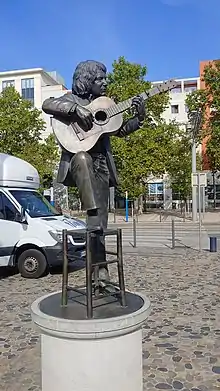Manitas de Plata
Ricardo Baliardo (7 August 1921 – 5 November 2014), better known as Manitas de Plata, was a flamenco guitarist of Spanish Gitano descent born in southern France.[1] Despite achieving worldwide fame, he was criticized for not following certain rhythmic rules (compás) that are traditional in flamenco.[2]
Manitas de Plata | |
|---|---|
 Manitas de Plata in 1968 | |
| Background information | |
| Birth name | Ricardo Baliardo |
| Born | 7 August 1921 Sète, France |
| Died | 5 November 2014 (aged 93) Montpellier, France |
| Genres | Flamenco |
| Occupation(s) | Musician |
| Instrument(s) | Guitar |
Life and career
Baliardo was born in a gypsy caravan in Sète, southern France.[1] He became famous by playing each year at the Saintes-Maries-de-la-Mer gypsy pilgrimage in the Camargue, where he was recorded live by Deben Bhattacharya.
Manitas de Plata ("Little Hands of Silver" in Spanish) agreed to play in public only 10 years after the death of Django Reinhardt.. One of his recordings earned him a letter from Jean Cocteau acclaiming him as a creator.[3]
Upon hearing him play at Arles in 1964, Pablo Picasso is said to have exclaimed "that man is of greater worth than I am!" and proceeded to draw on the guitar.[3]
De Plata attained fame in the United States after a photography exhibition in New York, organized by his friend Lucien Clergue. He had recorded his first official album in the chapel of Arles in France, in 1963, on the Philips label. It was later re-released, in 1967, on the Connoisseur Society label and sold through the Book of the Month Club. This popular LP brought him to the attention of an American audience. An American manager obtained a booking for him to play a concert in Carnegie Hall in New York on November 24, 1965.[4]
He toured the world from 1967, and recorded discs. He played with the dancer Nina Corti.[3] In 1968 he played at the Royal Variety Performance in London. He toured Australia in September 1972 supported by Los Baliardos (Hippolyte Baliardo, Manero Baliardo, José Reyes, Ricardo Bissaro).[5] His Sevillana was included in Scorsese's After Hours (1985) soundtrack.[6]
De Plata was the uncle of Jacques, Maurice, and Tonino Baliardo and cousin to Paul, François (Canut), Patchaï, Nicolas and André Reyes (the sons of his cousin, flamenco artist José Reyes (1928-1979), all members of the Catalan Rumba band Gipsy Kings. Australian multi-instrumentalist Chris Freeman, his student in 1971, acknowledged de Plata's influence and teachings.[7][8]

De Plata died aged 93 in a retirement home in Montpellier on 6 November 2014. He had suffered a severe heart attack in April 2013.
Many members of his own family were also well known flamenco musicians, including his younger brother Hippolyte Baliardo (1929-2009), and his eldest son Manero Baliardo (1940-2012). Another son, Bambo Baliardo, is still an active musician and performer as of 2015.
Selected albums
- Juerga! (1963, Philips, 844 535 PY)[9]
- Flamenco Guitar (1965)
- Flamenco Guitar
- Manitas de Plata - The world's greatest living flamenco artist (1966, Philips, BL 7787)
- Manitas et les siens (1967, Columbia Records, FL 363)
- Flamenco Magic (1967, Columbia Records, CS 9558)
- Flamenco!! (L'Espagne De Manitas) (1968, CBS, 63449)
- The Art of the Guitar (1968, Everest Records, SDBR 3201)
- La guitare d'or de Manitas (1970, Columbia Records, S 63915)
- Et Ses Guitares Gitanes (1972, CBS, S65020)
- Excitement of Manitas De Plata (1973, RCA Camden, CDS 1139)
- Hommages (1973, Embassy Records, S EMB 31003)
- Soleil des Saintes-Maries (1978)
- Feria Gitane (1994)
- Olé (1969)
- Manitas de Plata at Carnegie Hall (1995)
- Flaming Flamenco (1997)
- Manitas de Plata (1998)
- Camargue de Manitas (1999)
- Guitare D'Or Manitas de Plata (1999)
- Flores de mi corazon (1999, Troubadour Records)
- Guitarra Flamenco (2001)
- Manitas de Plata y los Plateros (2004)
See also
- Gitanos, Romani people in Spain
- Los Niños de Sara
References
- Pohren, Donn (1972), The Art of Flamenco, 3rd Edition, p. 79. "And the famous Manitas de Plata? A farce among flamenco guitarists, alarmingly deficient in his knowledge of flamenco, generally off even in his compás, of mediocre technique, but good, if nothing else, for a laugh."
- esbb.net Archived 2007-06-30 at the Wayback Machine; Biography of Manitas de Plata, accessed 6 November 2014. (in French)
- "Who makes music and where". New York Times. 21 November 1965.
- "AusStage". www.ausstage.edu.au.
- After Hours (1985) - IMDb, retrieved 2020-09-26
- McFarlane, 'Chris Freeman' entry at the Wayback Machine (archived August 3, 2004). Archived from the original on 3 August 2004; retrieved 27 June 2013.
- Bolton, Matthew (1 April 1982). "Show Scene". The Age. Fairfax Media. Retrieved 27 June 2013.
- Recorded in Arles, France, in October 1963, and featured Jose Reyes and Manero Baliardo, and the gypsies of Les Saintes Maries de la Mer. Producer E. Alan Silver; recording Engineer David B. Jones. Re-released by Connoisseur Society in 1967 as CS2003.
External links
- Profile, Foroflamenco.com; accessed 6 November 2014